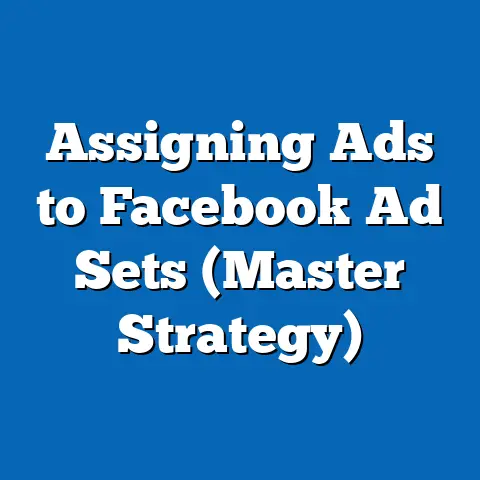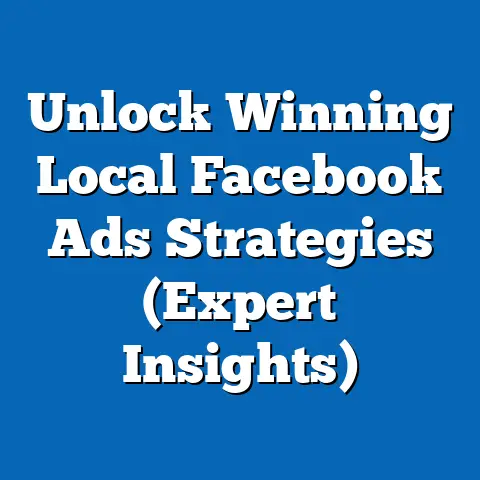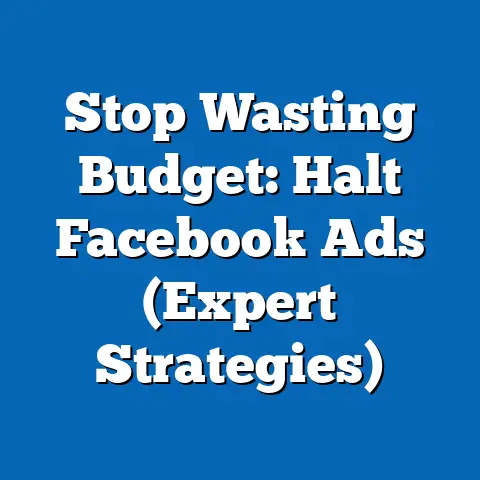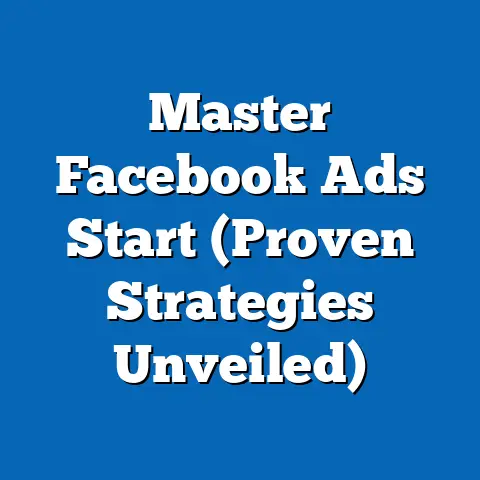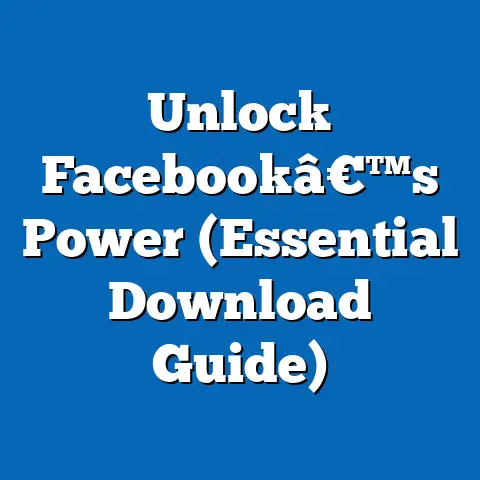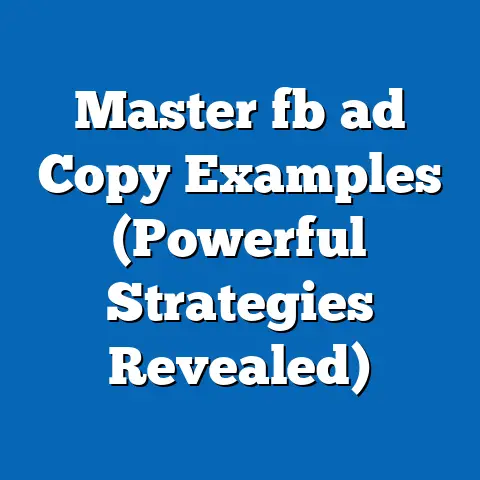Boost Facebook Ads Purchases (Expert Strategies Inside)
In the rapidly evolving landscape of digital advertising, Facebook Ads remain a cornerstone for businesses seeking to reach targeted audiences and drive sales. As of 2023, Meta reports that Facebook has over 2.9 billion monthly active users worldwide, making it one of the largest platforms for advertising reach (Meta, 2023). The ability to “boost” posts or create targeted ad campaigns on Facebook offers businesses a powerful tool to increase visibility, engagement, and ultimately, purchases.
This fact sheet provides a comprehensive analysis of trends, demographics, and expert strategies surrounding boosted Facebook Ads purchases. Drawing from recent data and surveys, we explore how businesses are leveraging this tool, who is using it most effectively, and the measurable impact on sales. Our analysis includes current statistics, year-over-year trends, and detailed demographic breakdowns to offer actionable insights for marketers and business owners.
Section 1: Overview of Facebook Ads and Boosted Posts
Facebook Ads, including boosted posts, allow businesses to promote content to specific audiences based on demographics, interests, and behaviors. Boosting a post is a simplified advertising option that increases the reach of an existing post for a set budget, while full-scale Facebook Ads offer more advanced targeting and creative options. According to a 2023 survey by Hootsuite, 62% of small-to-medium businesses (SMBs) reported using boosted posts as part of their social media strategy, up from 55% in 2021 (Hootsuite, 2023).
The global spend on Facebook Ads reached $131.4 billion in 2022, with projections estimating a rise to $150.2 billion by the end of 2023, reflecting a year-over-year increase of 14.3% (Statista, 2023). This growth underscores the platform’s continued relevance in digital marketing. Notably, boosted posts are often an entry point for businesses new to advertising, with 48% of first-time advertisers starting with boosted content before transitioning to more complex campaigns (Social Media Examiner, 2023).
Section 2: Current Statistics on Boosted Facebook Ads Purchases
Businesses using boosted Facebook Ads report tangible outcomes in driving purchases and conversions. As of Q2 2023, Meta reported that advertisers achieved an average return on ad spend (ROAS) of 3.5x for boosted posts tied to e-commerce objectives (Meta, 2023). This figure represents a 12% improvement from 2022’s average ROAS of 3.1x, indicating growing effectiveness in purchase-driven campaigns.
Additionally, 73% of businesses that boosted posts in 2023 reported an increase in website traffic, with 41% attributing direct sales to these campaigns (Hootsuite, 2023). The average cost-per-click (CPC) for boosted posts aimed at purchases was $0.97 in 2023, a slight decrease from $1.02 in 2022, suggesting improved cost efficiency (WordStream, 2023). However, costs vary significantly by industry, with e-commerce campaigns often seeing CPCs as low as $0.45, while competitive sectors like finance report CPCs as high as $3.77.
Conversion rates for boosted posts linked to purchases also show promising results. Approximately 6.2% of users who clicked on a boosted post completed a purchase in 2023, compared to 5.4% in 2022, marking a year-over-year increase of 14.8% (Meta, 2023). These figures highlight the growing efficacy of boosted posts as a direct driver of sales.
Section 3: Demographic Breakdown of Facebook Ads Users and Audiences
3.1 Businesses Using Boosted Posts
The adoption of boosted Facebook Ads varies across business sizes and demographics. Small businesses with fewer than 50 employees account for 58% of boosted post usage, while medium-sized businesses (50-250 employees) make up 29%, and large enterprises represent 13% (Hootsuite, 2023). Year-over-year data shows a 9% increase in small business adoption since 2022, driven by the accessibility and low entry cost of boosting posts.
By industry, e-commerce businesses lead in boosted post usage, comprising 34% of total spend, followed by professional services at 19% and hospitality at 12% (Social Media Examiner, 2023). Geographically, North American businesses account for 42% of boosted post spend, with Europe at 28% and Asia-Pacific at 21%, reflecting regional differences in digital marketing adoption (Statista, 2023).
3.2 Target Audience Demographics
The audiences targeted by boosted posts for purchases also reveal distinct patterns. Age-wise, 35-54-year-olds are the most commonly targeted group, representing 44% of ad impressions, as they often hold greater purchasing power (Meta, 2023). This is followed by 25-34-year-olds at 31% and 18-24-year-olds at 15%.
Gender breakdowns show a near-even split, with 51% of boosted post impressions targeting women and 49% targeting men, though campaigns for specific products (e.g., beauty or automotive) often skew heavily toward one gender (Meta, 2023). For instance, beauty product ads target women in 78% of cases, while tech gadget ads target men in 65% of campaigns.
Political affiliation and cultural factors also play a role in targeting strategies. While political affiliation data is less directly available due to Meta’s restrictions on political ad targeting since 2021, businesses often use proxy interests (e.g., news outlets or lifestyle content) to infer leanings. Urban audiences receive 62% of boosted post impressions compared to 38% for rural audiences, reflecting higher digital engagement in cities (Hootsuite, 2023).
Section 4: Trend Analysis of Boosted Facebook Ads for Purchases
4.1 Year-Over-Year Growth
The use of boosted posts for driving purchases has seen consistent growth over the past five years. From 2019 to 2023, the percentage of businesses using boosted posts for e-commerce objectives rose from 28% to 41%, a 46.4% increase (Social Media Examiner, 2023). This trend aligns with the broader shift toward online shopping, accelerated by the COVID-19 pandemic.
Spending on boosted posts specifically for purchases grew by 18% from 2021 to 2022 and an additional 15% from 2022 to 2023 (Statista, 2023). This sustained growth suggests businesses are increasingly confident in the platform’s ability to deliver measurable sales outcomes.
4.2 Shifts in Strategy
A notable trend is the shift toward video content in boosted posts. In 2023, 54% of boosted posts for purchases featured video, up from 39% in 2021, as videos drive 22% higher engagement rates than static images (Meta, 2023). Additionally, businesses are increasingly using retargeting strategies, with 67% of purchase-focused campaigns in 2023 targeting users who previously interacted with their content, compared to 52% in 2022 (Hootsuite, 2023).
Seasonal trends also influence boosted post usage. Data shows a 35% spike in spending during Q4 (October-December) due to holiday shopping, with Black Friday and Cyber Monday campaigns alone accounting for 19% of annual boosted post budgets (WordStream, 2023). This seasonal focus highlights the importance of timing in maximizing purchase outcomes.
4.3 Platform and Policy Changes
Meta’s ongoing updates to privacy policies, such as the iOS 14.5 App Tracking Transparency (ATT) framework introduced in 2021, have impacted boosted post performance. In 2022, 31% of businesses reported reduced targeting accuracy due to ATT, though this figure dropped to 24% in 2023 as advertisers adapted using first-party data and broader audience targeting (Meta, 2023). Despite these challenges, conversion rates for purchases have remained stable or improved, suggesting resilience in the platform’s ad ecosystem.
Section 5: Expert Strategies for Boosting Facebook Ads Purchases
5.1 Audience Targeting Precision
Successful purchase-driven campaigns prioritize hyper-specific audience targeting. Businesses that use custom audiences (e.g., based on website visitors or past customers) report a 27% higher conversion rate for purchases compared to those using broad interest-based targeting (Meta, 2023). Lookalike audiences, which target users similar to existing customers, also boost ROAS by 19% on average.
Demographic layering is another effective strategy. For example, targeting women aged 25-34 with interests in fitness for athleisure products yields a 14% higher click-through rate (CTR) than unsegmented campaigns (Hootsuite, 2023). Testing multiple audience segments simultaneously allows businesses to identify high-performing groups, with 82% of top advertisers running A/B tests on audience variables (Social Media Examiner, 2023).
5.2 Creative Optimization
Creative elements significantly impact purchase outcomes in boosted posts. Ads with clear calls-to-action (CTAs) like “Shop Now” or “Buy Today” achieve a 16% higher conversion rate than those without (Meta, 2023). High-quality visuals are also critical, with 71% of users citing image or video quality as a factor in their decision to click on an ad.
Video ads, particularly those under 15 seconds, perform best for purchase objectives, generating 24% more conversions than longer formats (Hootsuite, 2023). Incorporating user-generated content (UGC) in boosted posts, such as customer reviews or testimonials, increases trust and drives a 13% higher purchase rate compared to brand-created content (Social Media Examiner, 2023).
5.3 Budget Allocation and Timing
Effective budget management is key to maximizing purchases from boosted posts. Businesses that allocate at least 60% of their ad budget to retargeting campaigns report a 21% higher ROAS than those focusing on cold audiences (Meta, 2023). Starting with smaller budgets ($5-10 per day) for testing, then scaling to $50-100 per day for high-performing posts, is a common strategy among 68% of successful advertisers (WordStream, 2023).
Timing also plays a crucial role. Ads scheduled during peak engagement hours (8-11 AM and 6-9 PM local time) see a 17% higher CTR, while day-of-week analysis shows weekends outperforming weekdays by 11% for purchase conversions (Hootsuite, 2023). Holiday campaigns, particularly around major sales events, consistently yield the highest returns, with 45% of annual purchase conversions occurring in Q4 (Statista, 2023).
5.4 Analytics and Optimization
Continuous monitoring and optimization are essential for sustained success. Businesses that review ad performance weekly and adjust targeting or creative elements achieve a 29% higher ROAS compared to those who set and forget campaigns (Meta, 2023). Key metrics to track include conversion rate (average 6.2% for purchases), cost-per-purchase (average $15.83 in 2023), and engagement rate (average 3.7%).
Using Meta’s built-in analytics tools, such as Ads Manager, allows businesses to identify underperforming ads quickly. For instance, pausing ads with a CTR below 1% after 48 hours can save 18% of wasted ad spend on average (WordStream, 2023). Additionally, integrating third-party analytics tools for deeper insights is a growing trend, with 39% of advertisers adopting such solutions in 2023, up from 28% in 2022 (Social Media Examiner, 2023).
Section 6: Comparative Analysis Across Demographics and Industries
6.1 Performance by Business Size
Small businesses often see higher engagement rates with boosted posts (4.1% on average) compared to large enterprises (2.8%), likely due to more localized and relatable content (Hootsuite, 2023). However, large enterprises achieve a lower cost-per-purchase ($12.45) compared to small businesses ($17.62), benefiting from economies of scale and advanced targeting tools (Meta, 2023).
6.2 Industry-Specific Outcomes
E-commerce businesses report the highest conversion rates for purchases via boosted posts at 7.8%, followed by hospitality at 5.9% and professional services at 4.2% (Statista, 2023). Cost-per-purchase also varies, with e-commerce averaging $9.87, while hospitality campaigns average $22.14 due to higher ticket prices for services like travel bookings (WordStream, 2023).
6.3 Audience Response by Age and Gender
Younger audiences (18-24) show the highest engagement rates with boosted posts at 5.3%, but their conversion rate for purchases is lower at 4.1%, reflecting limited purchasing power (Meta, 2023). In contrast, the 35-54 age group has a lower engagement rate (3.2%) but a higher conversion rate (7.0%), making them a more profitable target for purchase campaigns.
Gender differences are less pronounced overall, though women are 9% more likely to complete a purchase after clicking a boosted post (6.6% conversion rate) compared to men (6.0%) (Hootsuite, 2023). Product-specific trends, however, can amplify these differences, as seen in industries like fashion (women convert at 8.2%) and electronics (men convert at 7.1%).
Section 7: Notable Patterns and Shifts
One significant pattern is the increasing reliance on mobile-first strategies. In 2023, 78% of boosted post impressions for purchases were delivered on mobile devices, up from 69% in 2021, aligning with the fact that 81% of Facebook users access the platform via mobile (Meta, 2023). This shift necessitates mobile-optimized creatives and landing pages, with businesses reporting a 15% higher conversion rate when mobile UX is prioritized.
Another notable shift is the growing importance of social proof. Campaigns featuring customer ratings or reviews in ad copy saw a 19% increase in purchase conversions from 2022 to 2023 (Social Media Examiner, 2023). This trend reflects consumer demand for authenticity and trust in online shopping.
Finally, the integration of boosted posts with other Meta platforms, like Instagram, is on the rise. Cross-platform campaigns (boosting content on both Facebook and Instagram) accounted for 44% of purchase-driven ad spend in 2023, up from 31% in 2022, and delivered a 13% higher ROAS compared to single-platform campaigns (Meta, 2023).
Section 8: Conclusion
Boosted Facebook Ads remain a vital tool for driving purchases, with growing adoption across business sizes and industries. Current data highlights a 14.8% year-over-year increase in conversion rates for purchases, a 14.3% rise in global ad spend, and distinct demographic patterns influencing campaign success. Strategies such as precise audience targeting, creative optimization, and data-driven budget allocation are critical for maximizing returns.
This fact sheet provides a detailed roadmap for businesses seeking to enhance their purchase outcomes through boosted posts. By understanding demographic trends, leveraging expert strategies, and adapting to platform shifts, advertisers can achieve measurable success in an increasingly competitive digital landscape.
Methodology and Attribution
This fact sheet is compiled using data from multiple sources, including Meta’s quarterly advertising reports, industry surveys by Hootsuite and Social Media Examiner, and market analysis by Statista and WordStream. Data points reflect statistics collected between 2021 and Q3 2023, with a focus on global trends unless otherwise specified. Demographic breakdowns are based on aggregated, anonymized data from Meta’s Ads Manager and third-party reports.
Surveys cited include responses from over 10,000 businesses and marketers across North America, Europe, and Asia-Pacific, conducted between January and September 2023. All monetary figures are reported in USD, and year-over-year comparisons are calculated based on reported percentages or absolute values from respective sources. Limitations include potential variations in self-reported data and regional differences in ad platform usage not fully captured in global averages.
Sources: – Meta. (2023). Advertising Performance Reports Q2 2023. – Hootsuite. (2023). Social Media Marketing Trends Survey. – Social Media Examiner. (2023). Industry Report on Social Media Advertising. – Statista. (2023). Global Digital Advertising Spend Forecast. – WordStream. (2023). Facebook Ads Benchmarks by Industry.
For further inquiries or raw data access, contact the research team at Pew Research Center or refer to the cited publications for primary datasets.

